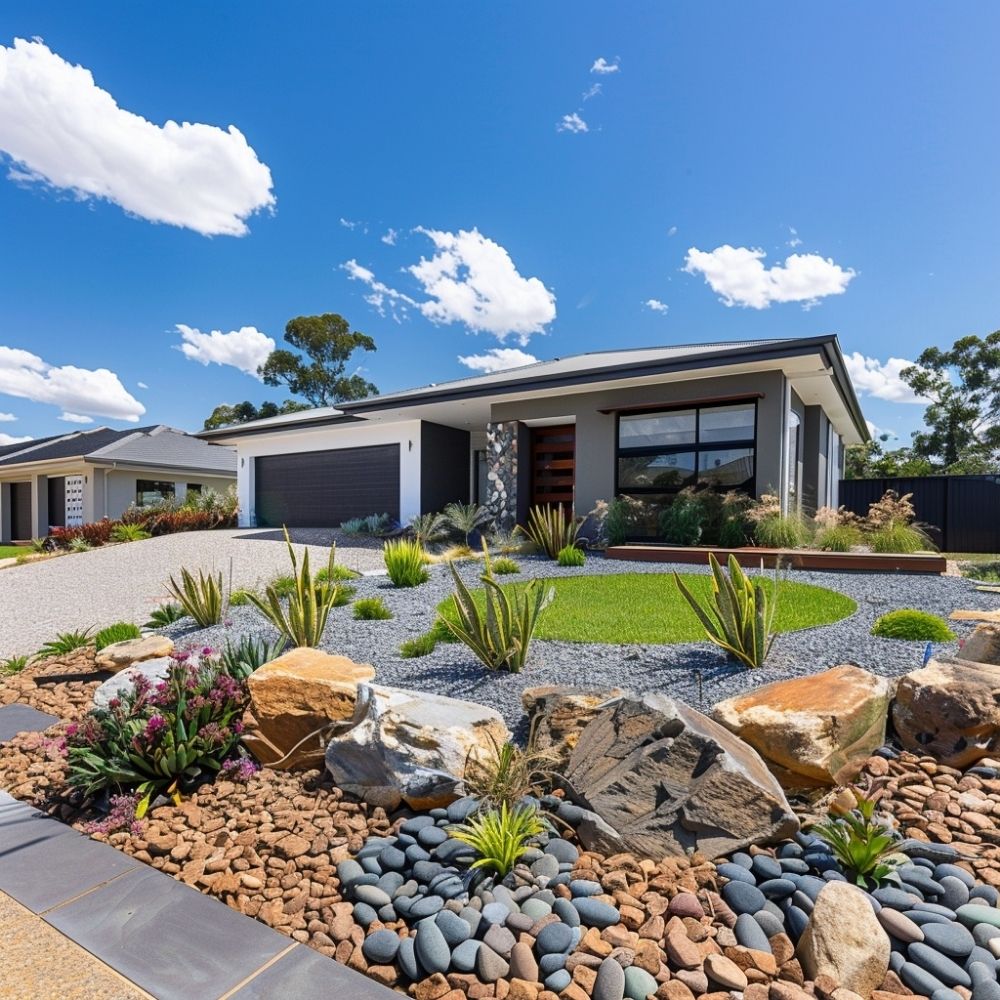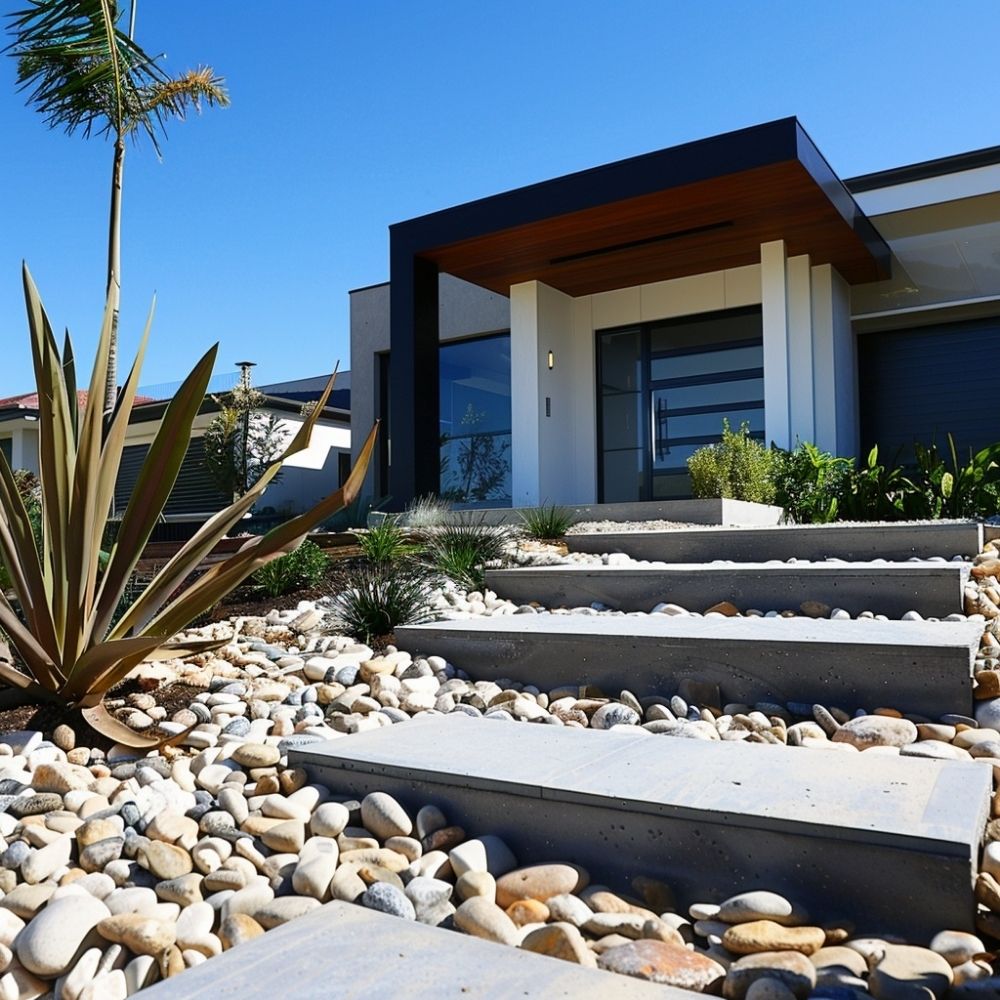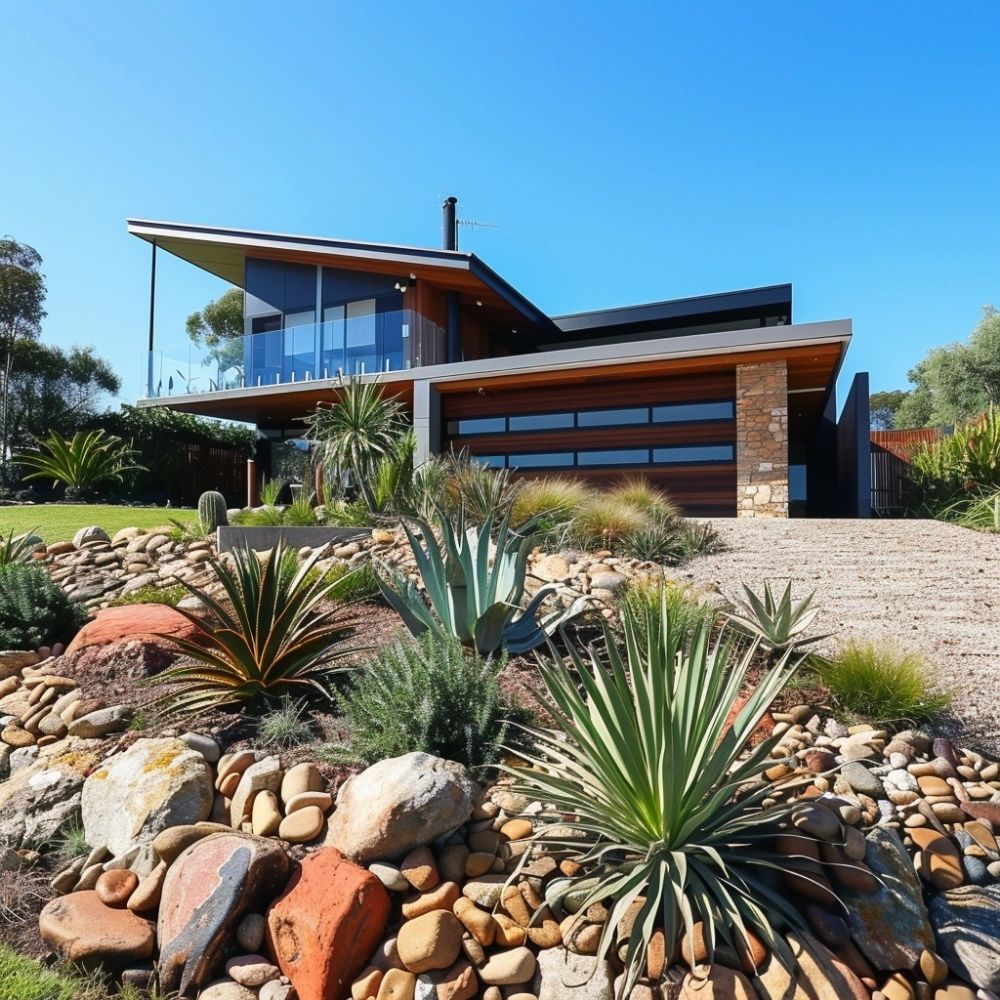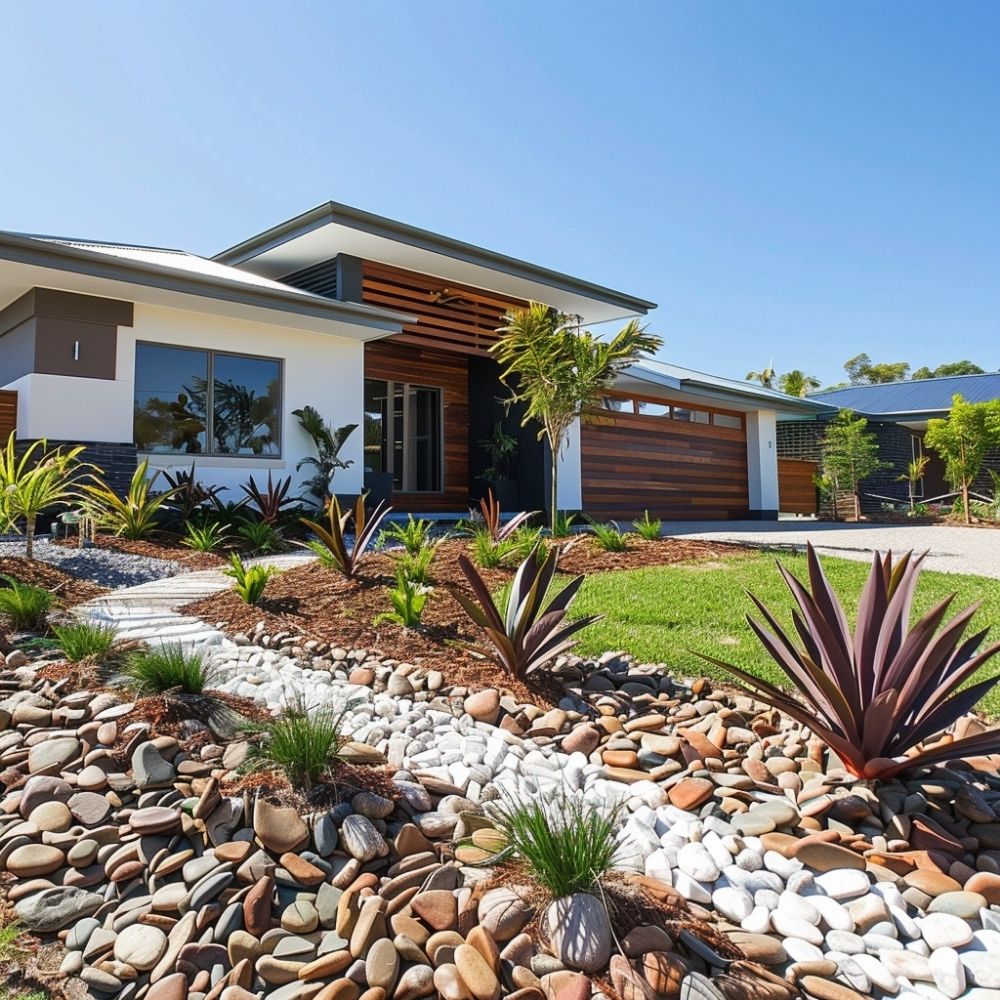Maintaining a lush, green lawn can be a relentless task, especially in Australia’s diverse climate. Between the constant watering, mowing, and fertilising, it’s no wonder many homeowners are seeking alternatives that are both beautiful and low-maintenance.
Rocks, with their natural textures and colours, offer a striking solution that can transform your front yard into a stunning, sustainable landscape.
Imagine a front yard where you no longer need to worry about the endless cycle of lawn care. Instead, picture a serene space filled with the earthy elegance of rocks, complemented by native plants and thoughtful design elements.
This shift not only enhances the aesthetic appeal of your property but also promotes environmental sustainability.
Let’s explore how you can create a captivating, rock-based landscape that stands out in your neighbourhood while reducing your maintenance efforts.
Why Choose Rock Landscaping for Your Front Yard?
Environmental Benefits
Rock landscaping contributes to sustainability. Rocks don’t require water, helping conserve this precious resource. Australian summers can be harsh, and rocks withstand these hot conditions without needing irrigation.
By replacing grass with native plants and rocks, you promote biodiversity. Native plants adapted to local climates thrive and support local wildlife. This choice also minimises the need for fertilisers or pesticides, which can negatively impact the environment.
Low Maintenance
Maintaining a rock landscape is less time-consuming. There’s no need for mowing or frequent watering. This means you save both time and money on upkeep.
Weeds are less of an issue with rock-based designs. Weed barriers beneath the rocks further reduce maintenance efforts. This gives you more time to enjoy your outdoor space rather than working on it.
Incorporate these design changes, and transform your front yard into a visually striking, low-maintenance haven.
Types of Rocks Suitable for No-Grass Front Yards
River Rocks

River rocks are smooth, rounded rocks shaped by natural erosion. They don’t pack tightly, so they’ll roll around when used. These rocks excel as decorative accents and aid in drainage. Use them to create a dry riverbed or border planting areas. Their varying colours add visual interest to your front yard.
Flagstones
Flagstones are versatile and perfect for creating pathways or patios. These sedimentary rocks can be sliced into various shapes and sizes. Choose from options like quartzite, slate, and limestone. Because of their flat surface, you can easily walk on them. Combine with other rocks or gravel for a layered look.
Pebbles and Gravel

Pebbles and gravel are ideal for walkways and garden borders. Pea gravel, being soft and smooth, works well for paths you frequently use. It adds texture and contrast, enhancing the overall design.
Crushed rock, also known as angular rock, has jagged edges. It’s great for areas around plants and as mulch. Use plastic or metal edging to contain smaller rocks. This keeps the pathways clear and prevents scattering.
Designing Your Rock-Based No-Lawn Front Yard
Planning Your Layout
Develop a solid plan before incorporating rocks into your front yard, and assess the existing terrain to identify focal points. Mark areas where you want paths, seating, or water features to guide how you position the rocks. To create depth, use rocks of varying sizes.
Consider placing larger boulders as centrepieces in open spaces. Integrate smaller pebbles and stones to form borders around flower beds or other planting areas. Using rocks to build raised beds adds dimension and interest.
Choosing the Right Colour Scheme
Select a colour palette that complements your home’s exterior. If your house has warm tones, choose rocks in tans, browns, and beiges. For homes with cooler tones, opt for greys, blues, and whites to create harmony.
Mix different shades to avoid a monotonous look. Lighter-coloured gravel can contrast nicely with darker boulders, while a splash of greenery can further enhance the visual appeal. Use this to highlight certain features, adding both aesthetic value and functionality.
By focusing on these aspects, you’ll create a stunning, low-maintenance front yard that stands out in any neighbourhood.
Key Elements of Rock Landscaping
Stone Pathways
Stone pathways lead visitors through your garden while adding an element of durability and style. Use flagstones for walkways to create a natural look. Pea gravel and river rocks are ideal for filling gaps, providing stability, and enhancing visual appeal.
Rock Gardens

Rock gardens elevate your front yard landscaping landscaping by creating dimensions and focal points. Use various rock sizes like boulders and pebbles to achieve texture and contrast. Incorporate plants like succulents and other drought-tolerant species that thrive in rocky soil.
Dry Creek Beds

Dry creek beds manage excess water and add aesthetic value. Line the bed with river rocks and pebbles to emulate natural water flow. Use larger rocks as focal points to create dynamic visuals, and consider adding vegetation to soften the overall look.
Adding Life with Plants
Incorporating plants can bring vibrancy to a rock-based front yard. Choose varieties that complement the hardscape elements and thrive in your local climate.
Suitable Plants for Rock Gardens

Select drought-tolerant plants suitable for rock gardens. Succulents and cacti need minimal water and maintenance. Opt for groundcovers like creeping thyme or sedum to fill gaps between rocks. They spread quickly, providing a lush, green contrast against the stone.
Integrating Plant Beds with Rocks

Layer plant beds around and between rocks for a natural look. Use native plants in these beds to cut down on watering needs. Consider ornamental grasses and shrubs for added height and texture. Mulch helps retain moisture and keeps weeds at bay, enhancing the overall aesthetics.
Practical Considerations for Rock Landscaping
Drainage and Soil Health
Proper drainage is essential for rock landscaping. Poor drainage can lead to water pooling, which damages plants. Incorporate a base layer of gravel or crushed stone under your main rocks.
This helps direct water away from plant roots. Also, consider the slope of your yard. Sloping yards facilitate better drainage. If your yard is flat, think about adding drainage ditches or perforated pipes to manage water flow.
Soil health is another crucial factor. Rocks can compact the soil beneath, affecting plant growth. Mixing organic matter like compost into the soil can improve its texture and fertility.
Additionally, choose plants that thrive in well-drained soil. Native Australian plants, succulents, and drought-tolerant species are excellent options.
Installation Tips
Installing rocks in your front yard involves some planning. Start with a clear design in mind. Sketch your layout to visualise how it will look. Place larger rocks or boulders first as these act as focal points. Position them in groups or singularly, depending on the desired effect.
For pathways, use landscape fabric under the rock layers to prevent weeds. Lay down a base layer of larger rocks before adding smaller ones on top. This stabilises the path and reduces the risk of rocks scattering. Use plastic or metal edging to keep rocks contained within designated areas.
Remember, rock placement is crucial. You won’t want to move them often due to their weight. If unsure about specific locations, consult with a landscaping company. They can offer professional advice and assist with lifting and positioning large rocks safely.
See
